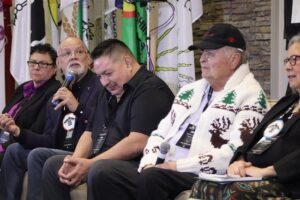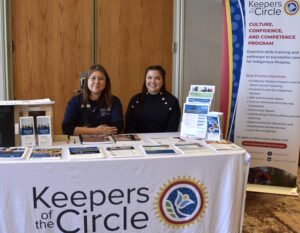Anishinabek Nation Lands and Resources Forum 2025 Everything is Connected

By Kelly Anne Smith
NORTH BAY—The Anishinabek Nation hosted the 9th Annual Lands and Resources Forum in North Bay February 11-13. The theme, Kina-Gego-Naabadosin, translates to everything is connected, and is a platform for community leaders, experts, partners, and government representatives to dialogue on the stewardship of First Nation’s community lands within the Anishinabek Nation.
Opening the forum, Deputy Grand Council Chief Chris Plain, formerly Chief of Aamjiwnaang First Nation for 20 years, says the connection to the land is important when we are talking about resource or economic development.
“(In Aamjiwnaang First Nation), we were able to generate a lot of our own source revenue. I think about in my Treaty, they surrendered 2.2 million acres. What we had left for the four reserves was very, very small…It’s been 200 years since they signed that Treaty. They signed with the intent of sharing, but did they intend on us being this impoverished?”
Deputy Grand Council Chief Plain sat on the Anishinabek Nation Leadership Panel alongside Northern Superior Regional Chief Mel Hardy, Southeast Regional Chief Marsha Smoke, Nipissing First Nation Gimaa Cathy Stevens, and Nmishomis Leroy Dolson. Southeast Regional Chief Smoke said the goals set out for the Forum are timely, especially about regional priorities and opportunities that are out there.
A presentation by Angel Ransom explored The Spirit of the Land toolkit, a collaboration between the Anishinabek Nation and First Nations Major Projects Coalition, which released in April 2024.
The Lands Administrator of Dokis First Nation Randy Restoule gave a comprehensive talk on the Dokis First Nation Land Management GIS and Drone Technology Mapping Project. The work has Dokis First Nation seeing drones being used in testing ice conditions and search and rescue, as well as mapping out Dokis First Nation and helping other First Nations do the same.
A wampum belt teaching was given by Dr. Alan Ojiig Corbiere of M’Chigeeng First Nation who says the voice of the lands is in our language.
A panel of the Anishinabek Nation Councils and the Anishinabek Chiefs Committee on the Environment were held during the Forum’s three days.
Forum break-out sessions were held about cultural burning; creating an invasive species management plan; the Great Lakes; traditional structure frameworks; GIS tools, applications, and resources; and incorporating land-based values and environmental stewardship.

Keepers of the Circle’s Alexandra Bridges from Mattagami First Nation gave her presentation entitled, Our Sacred Responsibilities: Missing and Murdered Indigenous Women and Girls Calls for Justice in Impact Assessments. Bridges says there are opportunities for health, social, and economic considerations that were previously not there before.
“Part of what we’ve done as a group, is we are really looking for mitigation strategies that would directly benefit Indigenous women and gender-diverse people particularly because we’re noticing they’re largely excluded from larger industrial projects and operations in the employment sector. And they are well behind in the training as well. Our interest is really to make sure that Indigenous women are getting the same opportunities because they are experiencing all of the negative consequences of development. In complement to industry community negotiations and benefit agreements, the regulatory process can be a pathway also to do that in a more transparent and public reporting method.”
The Agricultural and Food Security Panel had Nipissing First Nation’s Geneviéve Couchie, Joseph Goode from Chippewas of Georgina Island First Nation, and Silvia Sarapura from the University of Guelph talk about food sovereignty initiatives. Couchie walked through the process for the start up and operation of Nipissing First Nation’s Mnogin Greenhouse where three farms are now operational, and some local establishments utilize fresh produce and herbs grown at Mnogin Greenhouse. Silvia Sarapura explained a three-year project by Braiding Food Systems Research involving Netmizaaggamig Nishnaabeg, Biinjitiwaabik Zaaging Anishnawbek, and Red Rock Indian Band. Her talk is titled, Co-constructing Indigenous Seed Systems in Northern Ontario for Food Sovereignty, Security and Climate Adaptation.
Joseph Goode is the wild rice coordinator for Chippewas of Georgina Island First Nation, on the southern end of Lake Simcoe. With his talk, Manoomin on GIFN, Goode explained wild rice (manoomin) grew abundantly on the shores of Lake Simcoe and the First Nation a hundred years ago until the Port Severn waterway was built, raising the lake by three metres, wiping out the wild rice. In a community event last season, 250 lbs of seed was thrown into a growing area in a bay.
Robinson Huron Waawiindamaagewin’s Stefanie Recollet spoke on the comprehensive data that strengthens Anishinaabe assertions, recalling a saying, “Nothing has taken land more than the map.”
In closing the Lands and Resources Forum, Grand Council Chief Linda Debassige talked on the importance of sharing knowledge for those who don’t know, such as Members of Parliament.
“When they come into power, we have to provide them with training at that level as to our Anishinaabe ways. We need to teach them who we are, directly, as a mandatory component of coming into those [parliament buildings].”
Grand Council Chief Debassige discussed the Forum going on pause for 2026, calling the move exciting with the Lands and Resources team to venture out to First Nations.
“We are going to go and experience what it’s like in all of our communities and build a new Forum in the next couple of years based on that experience. We need to go back to the land…we’ll have a better ability to help advocate and support everyone of our communities for their needs.”
Prayers, teachings, and talks were shared by Anishinabek Elders including Head Getzit Mishoomis Richard Assinewai, Ookomis Donna Debassige, Mishoomis James Mishquart, Mishoomis Leroy Dolson, and Ookomis Evelyn McLeod.
The Nbiising Redhawks Drum Group performed the Mother Earth Drum for the opening and closing of the 2025 Lands and Resources Forum.


